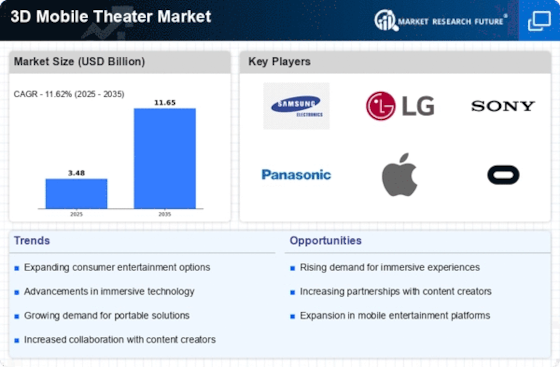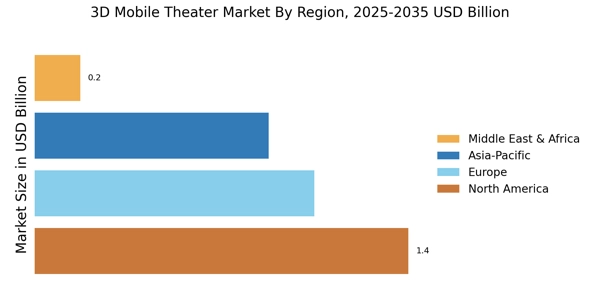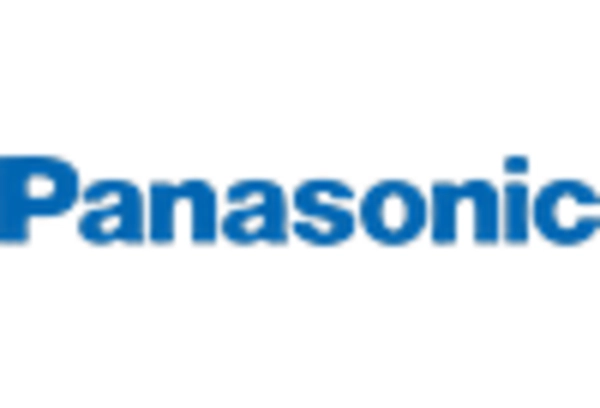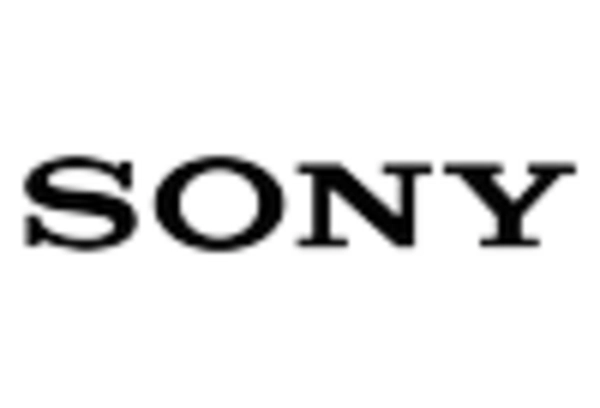Content Diversification in 3D Mobile Theater
The 3D Mobile Theater Market is witnessing a notable trend towards content diversification, which plays a crucial role in attracting a wider audience. With the rise of streaming services and mobile applications, consumers now have access to a plethora of content options, ranging from movies and documentaries to interactive experiences. This diversification is supported by data indicating that over 60% of consumers prefer platforms that offer varied content. As a result, content creators are increasingly focusing on producing high-quality 3D content that caters to diverse tastes and preferences. This trend not only enhances user engagement but also drives subscription models, thereby contributing to the overall growth of the 3D Mobile Theater Market.
Expansion of Mobile Technology and Connectivity
The 3D Mobile Theater Market is significantly influenced by the expansion of mobile technology and connectivity. With the proliferation of high-speed internet and advanced mobile devices, consumers are increasingly able to access 3D content on-the-go. Data indicates that mobile internet usage has surged, with projections suggesting that by 2026, mobile data traffic will increase exponentially. This accessibility allows for a seamless viewing experience, encouraging consumers to engage with 3D mobile theaters more frequently. Additionally, the rise of 5G technology is expected to further enhance streaming capabilities, reducing latency and improving overall quality. As mobile technology continues to advance, the 3D Mobile Theater Market is likely to see a corresponding increase in user engagement and content consumption.
Technological Advancements in 3D Mobile Theater
The 3D Mobile Theater Market is experiencing a surge in technological advancements that enhance the viewing experience. Innovations in display technology, such as OLED and microLED, are providing sharper images and more vibrant colors. Additionally, the integration of augmented reality (AR) and virtual reality (VR) is transforming traditional viewing into immersive experiences. According to recent data, the market for AR and VR is projected to grow significantly, potentially reaching billions in revenue by 2026. These advancements not only attract consumers but also encourage content creators to develop more engaging material tailored for 3D mobile platforms. As technology continues to evolve, the 3D Mobile Theater Market is likely to see increased adoption rates, as consumers seek out the latest in entertainment technology.
Outdoor Entertainment Growth and 3D Mobile Theater
The 3D Mobile Theater Market is benefiting from the growing trend of outdoor entertainment, which has gained traction in recent years. As consumers seek unique experiences, outdoor screenings and events featuring 3D mobile theaters are becoming increasingly popular. This trend is supported by data showing that outdoor movie events have seen a rise in attendance, with many venues reporting sold-out shows. The appeal of enjoying high-quality 3D content in an open-air environment is attracting families and groups, thereby expanding the market reach. Furthermore, partnerships with event organizers and local businesses are likely to enhance the visibility of 3D mobile theaters, contributing to the industry's growth. As outdoor entertainment continues to flourish, the 3D Mobile Theater Market is poised to capitalize on this opportunity.
Increased Consumer Demand for Immersive Experiences
The 3D Mobile Theater Market is experiencing increased consumer demand for immersive experiences, which is reshaping entertainment consumption patterns. As audiences become more discerning, they seek out experiences that engage multiple senses and provide a sense of presence. This demand is reflected in the rising popularity of 3D films and interactive content, which are designed to captivate viewers. Market data suggests that immersive experiences can lead to higher viewer retention rates, with some studies indicating that audiences are 70% more likely to recommend content that offers an engaging experience. Consequently, businesses within the 3D Mobile Theater Market are focusing on creating content that not only entertains but also immerses viewers in unique narratives, thereby driving growth and innovation.


















Leave a Comment